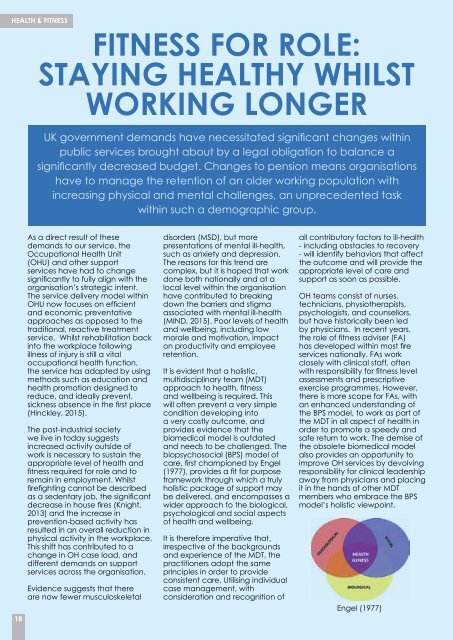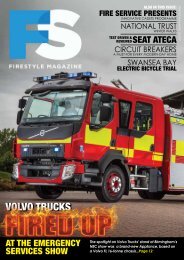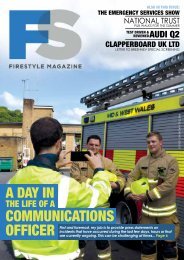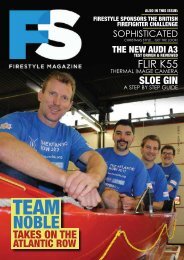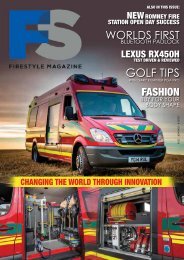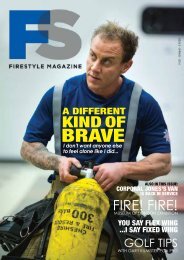Firestyle Magazine: Issue 1 - Autumn 2015
Welcome to the Firestyle Magazine – The Magazine for the 21st Century Fire and Rescue Services Personnel. Please visit our website for more: <a href="http://firestylemagazine.co.uk">http://firestylemagazine.co.uk</a>
Welcome to the Firestyle Magazine – The Magazine for the 21st Century Fire and Rescue Services Personnel. Please visit our website for more: <a href="http://firestylemagazine.co.uk">http://firestylemagazine.co.uk</a>
Create successful ePaper yourself
Turn your PDF publications into a flip-book with our unique Google optimized e-Paper software.
HEALTH & FITNESS<br />
Fitness for role:<br />
staying healthy whilst<br />
working longer<br />
UK government demands have necessitated significant changes within<br />
public services brought about by a legal obligation to balance a<br />
significantly decreased budget. Changes to pension means organisations<br />
have to manage the retention of an older working population with<br />
increasing physical and mental challenges, an unprecedented task<br />
within such a demographic group.<br />
18<br />
As a direct result of these<br />
demands to our service, the<br />
Occupational Health Unit<br />
(OHU) and other support<br />
services have had to change<br />
significantly to fully align with the<br />
organisation’s strategic intent.<br />
The service delivery model within<br />
OHU now focuses on efficient<br />
and economic preventative<br />
approaches as opposed to the<br />
traditional, reactive treatment<br />
service. Whilst rehabilitation back<br />
into the workplace following<br />
illness of injury is still a vital<br />
occupational health function,<br />
the service has adapted by using<br />
methods such as education and<br />
health promotion designed to<br />
reduce, and ideally prevent,<br />
sickness absence in the first place<br />
(Hinckley, <strong>2015</strong>).<br />
The post-industrial society<br />
we live in today suggests<br />
increased activity outside of<br />
work is necessary to sustain the<br />
appropriate level of health and<br />
fitness required for role and to<br />
remain in employment. Whilst<br />
firefighting cannot be described<br />
as a sedentary job, the significant<br />
decrease in house fires (Knight,<br />
2013) and the increase in<br />
prevention-based activity has<br />
resulted in an overall reduction in<br />
physical activity in the workplace.<br />
This shift has contributed to a<br />
change in OH case load, and<br />
different demands on support<br />
services across the organisation.<br />
Evidence suggests that there<br />
are now fewer musculoskeletal<br />
disorders (MSD), but more<br />
presentations of mental ill-health,<br />
such as anxiety and depression.<br />
The reasons for this trend are<br />
complex, but it is hoped that work<br />
done both nationally and at a<br />
local level within the organisation<br />
have contributed to breaking<br />
down the barriers and stigma<br />
associated with mental ill-health<br />
(MIND, <strong>2015</strong>). Poor levels of health<br />
and wellbeing, including low<br />
morale and motivation, impact<br />
on productivity and employee<br />
retention.<br />
It is evident that a holistic,<br />
multidisciplinary team (MDT)<br />
approach to health, fitness<br />
and wellbeing is required. This<br />
will often prevent a very simple<br />
condition developing into<br />
a very costly outcome, and<br />
provides evidence that the<br />
biomedical model is outdated<br />
and needs to be challenged. The<br />
biopsychosocial (BPS) model of<br />
care, first championed by Engel<br />
(1977), provides a fit for purpose<br />
framework through which a truly<br />
holistic package of support may<br />
be delivered, and encompasses a<br />
wider approach to the biological,<br />
psychological and social aspects<br />
of health and wellbeing.<br />
It is therefore imperative that,<br />
irrespective of the backgrounds<br />
and experience of the MDT, the<br />
practitioners adopt the same<br />
principles in order to provide<br />
consistent care. Utilising individual<br />
case management, with<br />
consideration and recognition of<br />
all contributory factors to ill-health<br />
- including obstacles to recovery<br />
- will identify behaviors that affect<br />
the outcome and will provide the<br />
appropriate level of care and<br />
support as soon as possible.<br />
OH teams consist of nurses,<br />
technicians, physiotherapists,<br />
psychologists, and counsellors,<br />
but have historically been led<br />
by physicians. In recent years,<br />
the role of fitness adviser (FA)<br />
has developed within most fire<br />
services nationally. FAs work<br />
closely with clinical staff, often<br />
with responsibility for fitness level<br />
assessments and prescriptive<br />
exercise programmes. However,<br />
there is more scope for FAs, with<br />
an enhanced understanding of<br />
the BPS model, to work as part of<br />
the MDT in all aspect of health in<br />
order to promote a speedy and<br />
safe return to work. The demise of<br />
the obsolete biomedical model<br />
also provides an opportunity to<br />
improve OH services by devolving<br />
responsibility for clinical leadership<br />
away from physicians and placing<br />
it in the hands of other MDT<br />
members who embrace the BPS<br />
model’s holistic viewpoint.<br />
Engel (1977)


